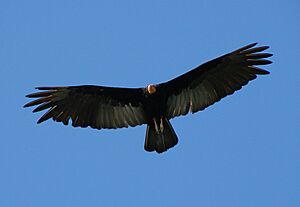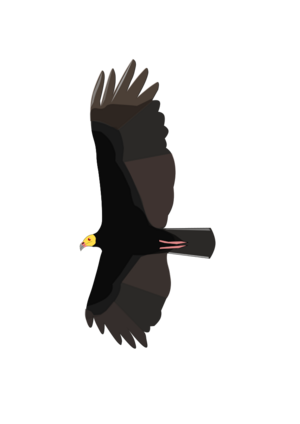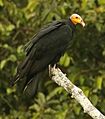Greater yellow-headed vulture facts for kids
Quick facts for kids Greater yellow-headed vulture |
|
|---|---|
 |
|
| Tucuruí, Pará | |
| Conservation status | |
| Scientific classification | |
| Genus: |
Cathartes
|
| Species: |
melambrotus
|
 |
|
| Range/distribution map of the greater yellow-headed vulture IUCN data. | |
The greater yellow-headed vulture (Cathartes melambrotus), also called the forest vulture, is a type of bird. It belongs to the New World vulture family. This bird lives in South America in warm, wet lowland forests.
For a bird, it is quite large. Its wings can spread out to about 166 to 178 centimeters (65 to 70 inches). It weighs around 1.65 kilograms (3.6 pounds). Its body is about 64 to 75 centimeters (25 to 30 inches) long. The feathers on its body are black. Its head and neck have no feathers. These parts can be a bright yellow or a light orange color. This vulture cannot make many sounds. It can only grunt or hiss quietly. This is because it does not have a special voice box called a syrinx.
The greater yellow-headed vulture eats dead animals, also known as carrion. It finds food by both seeing and smelling it. Being able to smell food is rare for birds. This vulture needs bigger vultures, like the king vulture, to help it. Its beak is not strong enough to open the tough skin of larger dead animals. Like other New World vultures, it uses warm air currents called thermals to fly easily. It lays its eggs on flat spots. These can be cave floors or inside hollow tree stumps. It feeds its babies by bringing up food from its stomach.
Contents
About the Greater Yellow-Headed Vulture
The greater yellow-headed vulture was first described as its own species in 1964. Before that, it was thought to be the same as the lesser yellow-headed vulture. The name of its group, Cathartes, means "purifier." This comes from an old Greek word. The word "vulture" comes from a Latin word meaning "tearer." This refers to how these birds eat.
Scientists are still learning about how New World vultures fit into the bird family tree. New World vultures and Old World vultures look similar and do similar jobs. But they grew from different ancestors in different parts of the world. Some scientists once thought New World vultures were more like storks. Now, many think they are in their own special group.
What Does This Vulture Look Like?
The greater yellow-headed vulture is about 64 to 75 cm (25 to 30 inches) long. Its wings can spread 166 to 178 cm (65 to 70 inches) wide. Its tail is about 25 to 29 cm (10 to 11 inches) long. On average, it weighs about 1.65 kg (3.6 pounds). Its feathers are black and can look shiny green or purple. Its throat and the sides of its head have no feathers. The skin on its head can be bright yellow to light orange. The top of its head is blue. The area near its nose is light pink.
The underside of its wings is black. Its main flight feathers are a lighter shade. When seen from above, the tips of its wing feathers look white. Its tail is rounded and long for a vulture. It reaches or goes a bit past its folded wings. Male and female vultures look the same. Young vultures look like adults, but their heads are a dull gray.
Its eyes have red centers. Its feet are black. Its beak is flesh-colored. The beak is thick, rounded, and hooked at the end. Its legs often have white streaks. This is from its habit of peeing on its legs to cool down. Its front toes are long with small webs. They are not good for grabbing things. Its nose holes are long and have no wall between them. Like all New World vultures, it cannot make complex sounds. It only grunts or hisses.
This vulture looks different from the similar lesser yellow-headed vulture. It is bigger and has a longer, wider tail. Its feathers are a dark, shiny black. The lesser yellow-headed vulture has browner feathers. Its legs are darker. Its head is more yellow than orange or pink. Its wings are wider, and it flies more steadily. It also has darker inner wing feathers. These stand out a bit from the lighter outer feathers. The greater yellow-headed vulture prefers forests. The lesser yellow-headed vulture likes open grasslands. The greater yellow-headed vulture is also a bit bigger than the turkey vulture. You can tell them apart up close by their different head colors.
Where Does This Vulture Live?
The greater yellow-headed vulture lives in the Amazon Basin in South America. You can find it in parts of Colombia, Venezuela, Guyana, French Guiana, Suriname, Brazil, Bolivia, Peru, and Ecuador. It does not live in the high Andes mountains. It also avoids open areas or southern subtropical regions.
It has a very large home range. This area is about 6.7 million square kilometers (2.6 million square miles). Its natural habitat is warm, wet lowland forests. It is common in areas with lots of trees. It might fly over grasslands sometimes. But it usually stays close to forests. Forests give it shelter and places to nest.
How Does This Vulture Live?
The greater yellow-headed vulture rests on tall, dead trees. From there, it can see the area around it. When it flies, it usually travels alone or in pairs. It is rarely seen in large groups. Its flight is strong and steady. It flies with its wings held flat or slightly raised. This is called the dihedral position. It uses warm air currents to stay in the air without flapping its wings much.
This vulture also has a special way to cool down. It pees or poops on its legs. The liquid then evaporates, which cools its body. This behavior is also seen in storks and other New World vultures.
Reproduction and Life Cycle
Greater yellow-headed vultures do not build nests. Instead, they lay their eggs right on cliffs, cave floors, the ground, or inside hollow tree stumps. The eggs are cream-colored. They have brown spots, especially on the wider end. A female usually lays two eggs, but sometimes one or three.
When the babies hatch, they are blind and have no feathers. They cannot move much. Later, they grow soft down feathers. The parents feed their young by bringing up food from their stomachs. The chicks then drink this pre-digested food. Young vultures are ready to fly after two to three months.
What Do Vultures Eat?
The greater yellow-headed vulture is a scavenger. This means it eats only dead animals. It will eat animals found on roads or other carcasses. These can be snakes, armadillos, dogs, foxes, or cattle. In forests, they likely eat many dead sloths, monkeys, opossums, rats, birds, and fish. It likes fresh meat best. But its beak is not strong enough to tear open the tough skin of larger dead animals. After a few days, it will stop eating a carcass. This is because the meat starts to rot and can have harmful germs. It will drink water from any pool or container.
Like other vultures, they are very important for the ecosystem. They help clean up dead animals. If these animals were left, they could spread diseases.
The greater yellow-headed vulture finds dead animals using its sharp eyesight. But it also uses its sense of smell. This is very unusual for birds. It can smell a gas called ethyl mercaptan. This gas is made when dead animals start to decay. The part of its brain that handles smells is very large. Humans have even used this vulture's amazing sense of smell. They put ethyl mercaptan into pipelines. Then, engineers follow the vultures to find gas leaks.
King vultures cannot smell dead animals. So, they follow the greater yellow-headed vultures to carcasses. The king vulture then tears open the skin of the dead animal. This lets the smaller greater yellow-headed vulture get to the food. Without the king vulture, it could not eat larger animals. This is an example of how two species can help each other. The greater yellow-headed vulture is often pushed away from food by turkey vultures and king vultures. This is because they are bigger.
Conservation Efforts
The greater yellow-headed vulture is listed as a species of least concern by the International Union for Conservation of Nature (IUCN). This means it is not currently in danger of disappearing. Its global range is about 6.7 million square kilometers (2.6 million square miles). There are between 100,000 and 1,000,000 of these birds. Some signs show its numbers might be going down. But this drop is not big enough to make it a threatened species right now.
Images for kids








